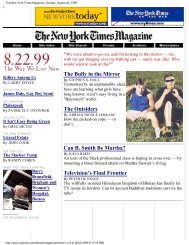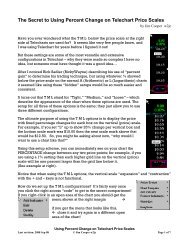The New York Times Magazine, Sunday, August 22, 1999
The New York Times Magazine, Sunday, August 22, 1999
The New York Times Magazine, Sunday, August 22, 1999
You also want an ePaper? Increase the reach of your titles
YUMPU automatically turns print PDFs into web optimized ePapers that Google loves.
<strong>The</strong> Bully in the Mirror<br />
only incorporated into the larger person you try to become. I think that's what<br />
Garry Trudeau, the formerly small cartoonist, had in mind when he described life<br />
as a tall adult as that of a "recovering short person."<br />
t was during his sophomore year, getting "the daylights pounded out of him"<br />
in wrestling and gaining even more weight, that Alexander began what he<br />
calls, with justification, his "drastic transformation." He started by losing 30<br />
pounds in one month. For a time, he consumed only 900 calories a day, and<br />
ultimately got down to 152 pounds. He began to lift weights seriously, every day<br />
for three months straight. He started to read magazines like Flex and Men's<br />
Fitness. He briefly dabbled with muscle-building supplements like creatine. He<br />
got buff, and then beyond buff.<br />
By the time his sophomore year in high school began, Alexander had packaged<br />
his old self in a phenomenally new body, and it has had the desired effect. "My<br />
quality of social life changed dramatically when I changed my image," he said.<br />
He still maintained friendships with the guys in the computer lab, still<br />
programmed, still played Quake with dozens of others. But he worked out at the<br />
gym at least five times a week. He shifted his diet to heavy protein. He pushed<br />
himself to lift ever-heavier weights. Until an injury curtailed his season, he<br />
brought new strength to his wrestling. Still, he wasn't satisfied. When I asked<br />
him if he ever felt tempted to try steroids during his effort to remake his physical<br />
image, he denied using them, and I believe him. But he wasn't coy about the<br />
temptation. "When someone offers you a shortcut," he replied, "and it's a<br />
shortcut you want so bad, you're willing to ignore what it might be doing to your<br />
insides. I wanted to look better. Who cares if it's going to clog up my kidneys?<br />
Who cares if it'll destroy my liver? <strong>The</strong>re was so much peer pressure that I didn't<br />
care."<br />
Alexander was especially pleased by the good shape he was in -- although he<br />
didn't care for aerobics, his resting heart rate was low, he ran a mile under six<br />
minutes and seemed to have boundless energy. But fitness was only part of what<br />
he was after. As he put it: "No one's looking for a natural look, of being thin and<br />
in shape. It's more of looking toward a level beyond that." He added that "guys<br />
who work out, especially guys who have six-packs and are really cut up, are the<br />
ones girls go after."<br />
To be honest, I was a little dubious about this until I spoke with an admittedly<br />
unscientific sampling of teen-age girls. It turned out that they not only agreed<br />
with the sentiment, but also spoke the same lingo. "If you're going swimming or<br />
something like that, girls like the stomach best," said Elizabeth, a 14-year old.<br />
"Girls like it if they have a six-pack, or if they're really ripped, as they say. That's<br />
the most important thing. And arms too."<br />
http://www.nytimes.com/library/magazine/home/<strong>1999</strong>08<strong>22</strong>mag-boys-self-image.html (13 of 18) [8/<strong>22</strong>/<strong>1999</strong> 9:17:23 PM]






